Where Science and Information Management Meet
For the Special Libraries Association Business and Finance Division Annual Conference
San Antonio, Texas, Convention Center, 4:45-5:30 PM, Tuesday, June 12, 2001.
by John H. Lienhard
Mechanical Engineering Department
University of Houston
Houston, TX 77204-4792
713-743-4518
jhl [at] uh.edu (jhl[at]uh[dot]edu)
It is a huge pleasure to be here among the information managers of this new century. You stand at the very center of a major shift in human affairs, and that shift is what I'd like to explore this afternoon.
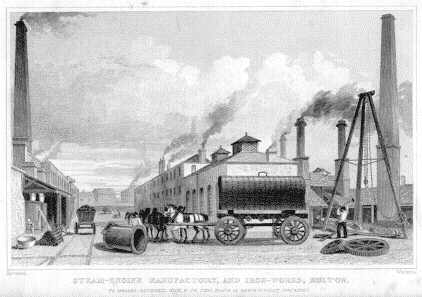 Two hundred and twenty-five years ago, the new coin of the realm was power -- coal and the new steam engines. Power was poised to change the face of Great Britain, and then of the whole world. In 1776, James Boswell, Samuel Johnson's famous biographer, spoke with James Watt's colleague Matthew Boulton. Boulton uttered a wonderful double-entendre. He told Boswell,
Two hundred and twenty-five years ago, the new coin of the realm was power -- coal and the new steam engines. Power was poised to change the face of Great Britain, and then of the whole world. In 1776, James Boswell, Samuel Johnson's famous biographer, spoke with James Watt's colleague Matthew Boulton. Boulton uttered a wonderful double-entendre. He told Boswell,
I sell here, Sir, what all the world desires to have, POWER!
That was then. Now our world is again being shaped by a new specie. The new coin of the realm is information. Information is literally replacing both power and material goods. Take the jet airplane: Today it looks pretty much the same as it did forty years ago. What's changed is its efficiency. Flight is now computer-managed to the point that the airplane burns about half as much fuel as it once did. Information has replaced expensive kerosene.
The same is true of production. Information management has greatly reduced waste. Fewer products rot or become obsolete in warehouses. That's because the information gulf that once separated consumers from the production line is being reduced daily. And so it is quite literally true that information is replacing the material realities that we once thought were irreplaceable. That fact of our new world is something that would've struck most of us as implausible, even as late as 1980.
Only twenty years after Boulton made his wonderful remark to Boswell, the Romantic poets began telling us something that signaled today's information revolution. They made the wonderfully counterintuitive claim that we create nature by dreaming nature. And they meant it! They were telling us that nature has no meaning outside the human conception of it.
In 1962, Thomas Kuhn took that idea another step forward in his remarkable book, The Structure of Scientific Revolutions. You remember how people seized upon Kuhn's use of the word paradigm for any established body of science. In fact, some people almost destroyed the word by over-using it. But listen to what Kuhn actually says at the end of one chapter:
I have so far argued only that paradigms are constitutive of science. Now I wish to display a sense in which they are constitutive of nature itself.
Suddenly a historian of science is telling us precisely what the Romantic poets told us, and we might well find it very off-putting. But then Kuhn explains himself. He begins the next chapter by saying,
... the historian of science may be tempted to exclaim that when paradigms change, the world itself changes with them. Led by a new paradigm, scientists adopt new instruments and look in new places. Even more important, during revolutions scientists see new and different things when looking with familiar instruments in places they have looked before. It is rather as if the professional community had been suddenly transported to another planet ...
And this is precisely what's happening to us.
Suppose, for example, that you and I lived in America in 1850 and were thinking about Hong Kong. We'd gaze out upon our flat horizon and imagine a three-month journey on a sailing ship. By now, however, we've seen the curved horizon from 35,000 feet. Ever since the moon landings, we've regarded Earth as a gossamer blue and white sphere floating in inky black space. And we measure the trip to Hong Kong in hours, not months.
So Earth simply cannot be the same place for us as it was for our great grandparents. And yet, you and I believe that nature out there has some absolute character that doesn't depend on the way we see it. There must be an objective nature that's independent of what we see.
But, the point is, that's not entirely relevant. After all, if nature isn't what I actually see, then what credence can I give to the view from my window? Different skeins of experience really do alter what you and I see when we look at the same thing. Why else is my childhood home so small when I return to it as an adult?
Technology is the factor that most rapidly and dramatically changes reality for us. When Galileo turned his new telescope on the moon, he made it clear, for the first time, that the moon had a rough surface. Our night sky has, ever since, included, not a perfect celestial sphere, but a pockmarked rock reflecting the sun. From that small step in human perception flowed a whole new way of looking for, and looking at, reality. It was a major step in creating the methods of modern science and in changing what we expected of science.
We catch a glimmer of objective nature in our measuring instruments. But our actions are ultimately shaped by what our mind makes of that glimmer.
Now the Internet pours new images and information into our lives. Never before have we had at hand so much knowledge of nature. Our perception of reality is shifting on so large a scale there's no telling where it's going. Nor can we ever know ahead of time how our behavior will change each time we recreate nature within us.
For all practical purposes, our changing perceptions really are changes within nature itself. Of course you and I believe that nature has some ultimate character, without our witness to it. That belief keeps us honest. It forces us to keep stretching and changing what we see.
But the Romantic poet Wordsworth clearly saw that we're inevitably woven into what nature is. He captured the intimacy between our mind and nature in his poem Tintern Abbey. He first recalled the wild country surrounding the ruins of the old Abbey. Then he said,
... that blessed mood, …
In which the heavy and the weary weight
Of all this unintelligible world,
Is lightened:--that serene and blessed mood,
In which the affections gently lead us on,--
Until, the breath of this corporeal frame
And even the motion of our human blood
Almost suspended, we are laid asleep
In body, and become a living soul:
While with an eye made quiet by the power
Of harmony, and the deep power of joy,
We see into the life of things.
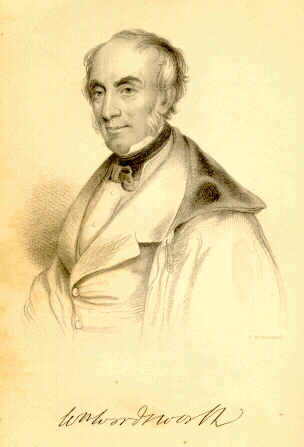
William Wordsworth
Those are wonderful lines, but they're also disturbing. Is nature really a harmony we form from the weary weight of the otherwise unintelligible world? If nature really is what we make of sense data, then we carry an even larger responsibility than we once thought.
I think you can see where I'm going with this. Information has assumed an authentic primacy over matter. And it is a primacy that we never before imagined to be there. We certainly see it happening. And now we have to ask, what is it that empowers technology to so affect our reality?
Well, for a technology to succeed it must have a seldom-talked-about quality. For a technology to become a part of our lives, it must also become a part of our metaphorical vocabulary. And practically all our cultural metaphors are technological: "He had a will of iron." "She hid her candle under a bushel basket." "The storm came up suddenly; it hit us like an express train." "You really hit the nail on the head."
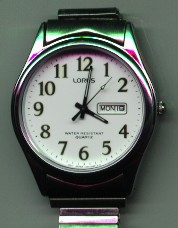 Clock metaphors, in particular, surround us: "The team functioned like a Swiss watch." "We had to hurry; the clock was ticking." So let's think for a moment about clocks. The circular face of a sundial, with its shadow moving left to right, was copied straight onto the faces of ancient water clocks. Water clocks used a float in a steadily draining tank to tell time. But that float drove gears, and the gears drove hands around a dial.
Clock metaphors, in particular, surround us: "The team functioned like a Swiss watch." "We had to hurry; the clock was ticking." So let's think for a moment about clocks. The circular face of a sundial, with its shadow moving left to right, was copied straight onto the faces of ancient water clocks. Water clocks used a float in a steadily draining tank to tell time. But that float drove gears, and the gears drove hands around a dial.
Then, around AD 1300, the tick-tock mechanical escapement radically improved clock accuracy. It made clocks smaller and cheaper. But, changed as they were, clocks still had dials, bells, and gears. Medieval writers had almost nothing to say about the new mechanism inside, so historians still aren't sure exactly when the mechanical escapement took over. The outward form, the clock face, could not change, because that's where the metaphor was expressed. And medieval writers looked at the metaphor, not the machinery inside, when they mentioned clocks.
Around 1920, another radical change took place in clocks: This time, electrical timing elements used the steady oscillation of alternating current to replace the mechanical escapement. Accuracy took another leap forward. But clocks still looked the same. Quartz crystals have further confused the issue. My desk clock not only has the circular face of a sundial or a water clock; it also has a second hand that moves in little jumps -- as though it were controlled by an escapement mechanism. Designers understand, on a visceral level, that the meeting ground between user and machine has to sustain the old metaphors.
So what about digital clocks? They offer a more precise readout than analog clocks do. They're easier for children to read. They show linear time -- time as a sequence of rising numbers. That's pure simplicity. Of course it's simplicity in the same way a tree is simpler than a forest.
A circular dial paints a picture of Earth's rotation. It models our own experience of passing time. It's a lovely analog of reality. In a digital display, night never falls. Time just advances, without features, minute after minute. And so the competition between analog and digital readout might seem to be in balance. But! What do most of you wear on your wrists? The fascinating truth is, the digital clock has already lost in that competition.
The digital clock simply can't compete with the metaphorical power and visual grace of the circling motion of an analog face. The one place the digital face remains in our lives is in our bedside alarm clock. It isn't meant to be a companion during the day; it's meant only to tell us whether or not 6:30 AM has yet arrived.
Many technologies look good for a while; then they get left -- Betamax, dirigibles, LP's, autogyros, and digital watches as well. So what does survive, and why? If you want to predict the death or survival of a technology, you certainly ask if it's functional. But that's never enough by itself. You have to ask if it's a metaphor for something more than function. Only after a technology has touched us in that deep visceral and emotional place will it find a way to persist from one generation to the next.
And so we come to the technology of the book in its codex form -- gatherings of rectangular pages, sewn together between covers. It was invented in Pergamon in the second century BC, and it might well be the most powerful technological metaphor of them all. Once a technology finds that metaphorical place in our psyche, its outward form will survive. The user interface will not be given up.
Remember what happened when Gutenberg began printing with movable metal type. He made print look just like the work of scribes. He literally counterfeited the old manuscript books. It often takes a trained eye to tell an early printed book from a manuscript book. And books today still keep most of those features. We still fold pages into gatherings, sew gatherings together, and lace them between hard covers. Movable metal type made books cheap and abundant. But we still use the technology that came out of Pergamon over 2200 years ago.
And, when I work at my personal computer, I use what's clearly recognizable as a typewriter keyboard. That arrangement's over a century old. Once more, the place where I meet the machine, for all its imperfect arrangement, is old and well-loved. It will not be abandoned.
Friends ask me, over and over, "How much change will we have to undergo?" The answer is that, where the user meets the machine, is the last place we'll tolerate change -- even though the machine itself is mutating into something so different as to redirect human history.
We do indeed bend ourselves to each new machine. But where the machine has become metaphor is where that process stops. Think about pianos: They evolved from harpsichord improvements. But they were soon something wholly different. Pianos are so different from harpsichords that you still need a harpsichord when you want to hear harpsichord music. Many technologies survive their replacements that way. Live concerts have survived recordings. Pens survive word processors.
The computer has also leap-frogged the old technologies of printing and writing. But book-reading and letter-writing are secure in its wake. As the computer finds its way around the limitations of the paper book, electronic information is already completely different in character from that in a paper book. And that's exactly why the paper book has to survive, after all.
Paper books will keep right on doing what they've always done so well. They take you into the author's mind. You give yourself over to her story-telling rhythm. Your own mind frames the pictures and plays the music. And I believe it's also important that you feel organic cloth and paper against your fingers.
And this brings me to a point that some of you may've heard me make before. It's one that I believe is terribly important and needs to be repeated: Not only has the book long since found its metaphorical place in our lives. But, in twenty years time, the personal computer has already carved out its own metaphor. We now have two complementary metaphors, both of which shape our twenty-first-century understanding of reality.
The book has long been our metaphorical mentor.
The computer has become our metaphorical servant.
We all switch between the roles of parent and child. In some things, we need to be in charge. In others, we'd better know how to submit ourselves to other people's knowledge. The child says, "Tell me a story." The story might be a Gothic novel. It might be a mathematics textbook. In either case, we have to give ourselves over to the storyteller if we hope to profit from the story. We do that when we read a book or when we go to the theater. We do it when we listen to a concert.
Computer communications are another matter. The computer does our bidding. We say, "Buy me an airplane ticket. Give me a stock quotation. Tell me if the library has a book. Deliver this message to a friend." The computer dances to our tune. We are in control. When we go to the computer for text material, it's to look things up. It's not to let words wash over us. The computer is far better than a book if we want only to find things. Insofar as paper books function as simple repositories of fact, they've already given way to computers.
But the book to which we submit ourselves will have to remain written out and uncontrollable. It's an important omen that the first books offered on computers gave readers control over the story. It's no accident that those embryonic computer books were ones that let you choose the direction for the plot to take.
To learn, we have to seek out our own ignorance. Now and then we follow the mind of someone who knows what we do not. We yield to the rhythm of the story-teller. Printed books let us put control aside for a while. That's the wonderful gift books offer. The metaphor of the computer, on the other hand, has also been set in concrete. Whatever we can do with electronic media, we simply will not use them as mentors.
Now, the dark side of all this: The emergence of a new technological metaphor means revolution. It means seeing nature differently, and that means trouble. For all practical purposes, any new technological metaphor means an altered reality. Each major communication revolution has brought a new metaphor into our lives, but it's also brought upheaval with it. What happened when Gutenberg printed his Bible in 1455?
Few people today have any idea just how rapidly printed books appeared after Gutenberg. Estimates vary as to how many books had been printed by 1501, five hundred years ago. But the number is somewhere between eight and twenty-four million books, with upwards of forty thousand titles. In a blink, we'd gone from a world in which the technology of bookmaking was rare to one in which it was ubiquitous. So what was the result? What did those new books really do?
We spend so much time praising the new literacy that we overlook the mischief. Books caused an explosive renaissance of the writings and values of Classical Greece. As part of that renaissance we coupled Aristotle's almost-forgotten observational science with the new use of block-print illustration. And the more refined copper-plate engravings soon followed.
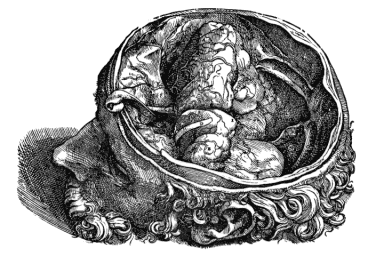
Andreas Vesalius' block print of a human skull, 1543
Medieval scholarship had been Platonist through and through. For those of you who know the Meyers-Briggs test, Medieval scholars were dominantly N-types, not S-types. They looked inside their mind for understanding, not to the outside world. But the message embedded in all those books was that knowledge comes from outside ourselves. The new scientists of the sixteenth century were predominately Aristotelian S-types. That led to the creation of a whole set of new observational sciences -- botany, anatomy, geography, ethnography, descriptive geometry. None of those existed in any form you or I would recognize before the sixteenth century.
And so nature really did change utterly. The average citizen living in 1620 saw a world that would've been unrecognizable to, say, Gutenberg. We also moved away from the old deductive philosophies. We had to wait for a crypto-alchemist named Isaac Newton to create a new synthesis of internal and external thinking. We had to wait for the Romantic poets to tell us to look, once again, into the human mind to form our knowledge of nature.
So the new books stirred science up and redirected it. That new direction eventually proved to be a bit monothematic and limited. Nevertheless, science needed a shaking up at that point, and that's what it got. But other dimensions of classical Greek thinking were more sinister. Hellenic civilization had highly honed such practices as slavery, male dominance, and organized war.
Now those values came back with a vengeance. The new central-European Protestants were the first and major book printers, and they were also the worst of the new witch-burners. Don't for a minute think that the new book-readers were an entirely enlightened people. Books meant trouble. People derived all sorts of mischief from them. They caught bits and pieces of learning, and they often drew strange, even sinister, conclusions from them.
How then does all this affect you? Let me begin by asking whether you are content to see your role limited to that of record-keepers. You'd be very wrong if you did. As managers of the new technologies of information management, it is you who're shaping new metaphors for reality. The business of redefining nature consequently falls to you.
And I'm not kidding when I say that. That role is inescapable. We live in an age when information literally overlaps materiality. We live at time when information is bringing about radically new realities. I keenly see and feel that responsibility as I function both as a teacher and on the radio -- as I try to synthesize and distribute information. But you manage the storehouse.
You are primary players in the business of deciding what we can abandon and what we must retain. Even more important, you manage the avenues of access to information. And you're working in a world where, tomorrow, nothing will be as it seems today.
Early last Saturday morning it began raining very hard in Houston. My wife and I got up to watch the street in front of the house. By 2:00 AM, it was a river whose edges were lapping on the front lawn. By 2:30 it started seeping into the house. By dawn, water on some major highways had risen to the roofs of stalled eighteen-wheelers. Twenty-seven thousand homes and buildings were damaged. If you yourself weren't driven from your home, you had friends who were. The toll in money ran over four billion dollars. The direct toll in human lives grew to more than twenty. But others eventually died after power for hospital life-support systems had gone out.
And, yet, it was only rain. Rain that'd fallen upon us so many times in the past and done no more than refresh the ground. So many little raindrops had added up until what we saw bore no resemblance to mere raindrops.
By 1501, the torrent of twenty million new books had become something that books alone had never before been. Now, five hundred years later, we've just acquired a billion new computers. Those computers have, long since, formed a new metaphor.
We can be very sure that the new flood of information will form a new reality. None of us has a clue as to what shape and form that reality will have. Yet we bear the full responsibility for bringing it into being. And if that doesn't fit your idea of fun -- or mine -- well, then let me finish with a quotation from Alcuin of York. He was the Scholar whom Charlemagne hired in the eighth century and charged with bringing literacy to Europe. Alcuin wrote,
O quam dulcis vita fuit
dum sedebamus in quieti ...
inter librorum copias.
That translates into a wonderfully poignant thought for all of us who still love the old books -- and the old reality -- even while we commit ourselves to creating the new information media and a whole new view of reality.
What Alcuin's words say, is this:
Oh how sweet life became
When we sat together in quiet ...
Midst all those books.
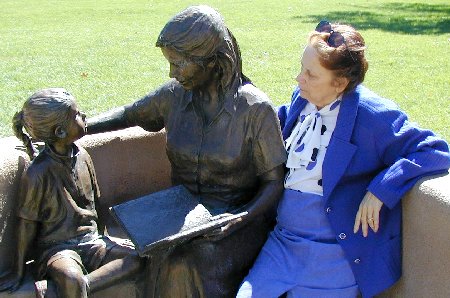
SOME SOURCES
For more on the Matthew Boulton quote and its significance, see: https://engines.egr.uh.edu/talks/powersir
Kuhn T., The Structure of Scientific Revolutions. 2nd ed. Chicago: University of Chicago Press, 1970. (See the end of Chapter 9 and the beginning of Chapter 10.)
For some thoughts on the relation of the Romantic poets and eighteenth-century science, see: Jennings, H., Pandaemonium, 1660-1886. New York: The Free Press, Macmillan, Inc., 1985. See also: https://engines.egr.uh.edu/episode/531 .
Edgerton, S.Y., Jr., Galileo, Florentine 'Disegno,' and the 'Strange Spottednesse' of the Moon. Art Journal, Vol. 44, No. 1, 1984, pp. 225-232.
Ashworth, W. B. Jr., The Face of the Moon: Galileo to Apollo: an Exhibition of Rare Books and Maps, October 13, 1989 -- February 28, 1990, Kansas City, MO: Linda Hall Library, 1989.
For the full text of Wordsworth's poem, Tintern Abbey, see, e.g., http://www.bartleby.com/145/ww138.html or
http://www.library.utoronto.ca/utel/rp/poems/wordswor3.html
Rohr, R.R.J., Sundials: History, Theory, and Practice. Toronto: University of Toronto Press, undated.
Marshall, R.K., Sundials, New York: the MacMillan Company, 1963.
Sarton, G., Galen of Pergamon, Lawrence, KA: University of Kansas Press, 1954, Chapter II.
Hansen, E.V., The Attalids of Pergamon. 2nd ed., Ithaca: Cornell University Press, 1971.
Eisenstein, E. L., The Printing Press as an Agent of Change. Vol. I and II, Cambridge: Cambridge University Press, 1979. See especially, Part One, Chapter 1, "The Unacknowledged Revolution."
Bozeman, L.P., Fadell, J.E., and Lienhard, J.H., INCUNABULA: 1455-1500, The Cradle Years of Book Printing. Houston, TX: University of Houston Library, Catalog of an Exhibit of the same name, October 1995 to January 1996.
For the story of the familiar QWERTY typewriter keyboard, see: Gould, S.J., The Panda's Thumb of Technology. Bully for Brontosaurus: Reflections in Natural History. New York: W.W. Norton & Company, 1991, Chapter 4.
For an interesting commentary on Newton as Platonist/alchemist, see: Gregory, R.L., Even Odder Perceptions. New York: Routledge, 1994, (Chap. 22: Good as Gold: Newton's Alchemy of Matter and Mind.)